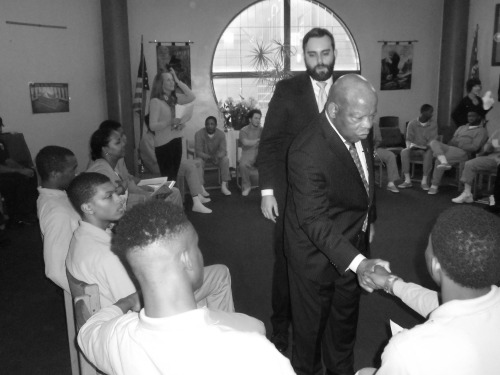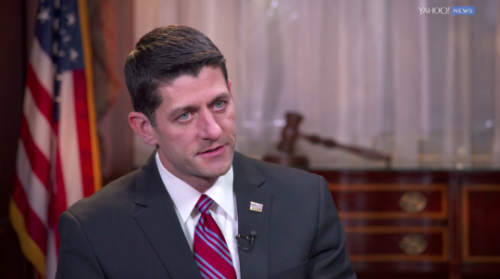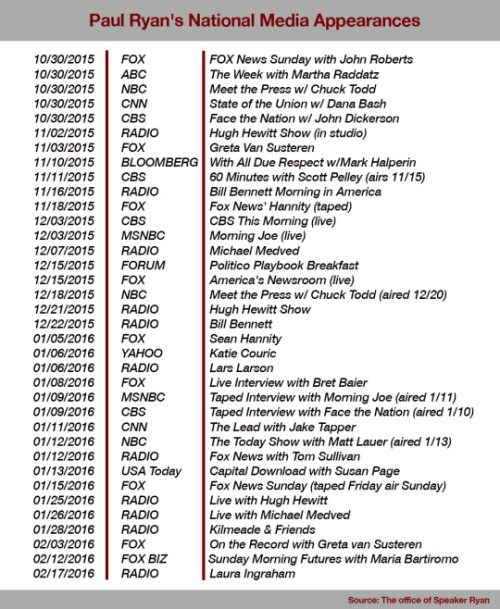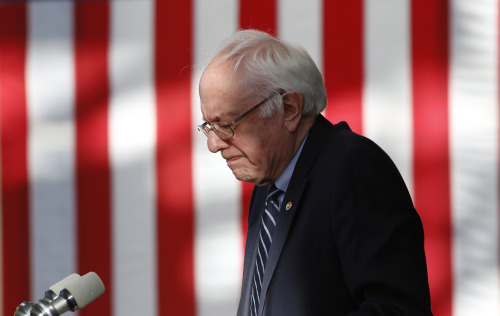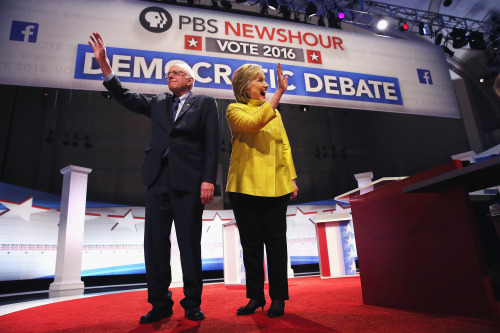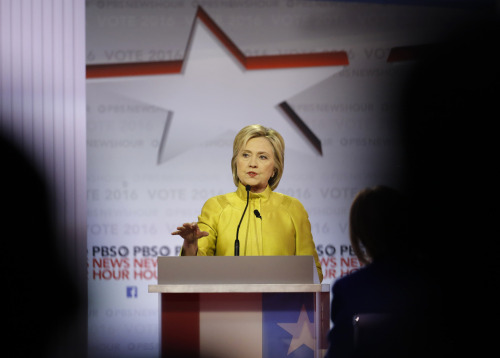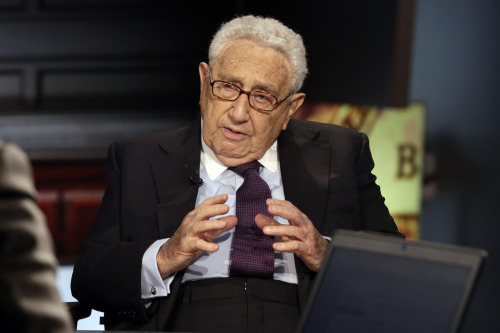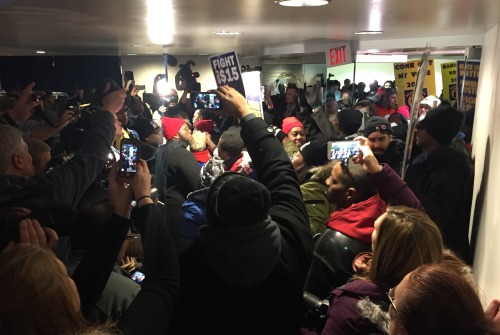Cory Booker: Senator Snapchat

Sen. Cory Booker, D-N.J., and Sen. Kirsten Gillibrand, D-N.Y., take a selfie with pages in the Capitol’s Senate Reception Room in January. (Photo: Tom Williams/CQ Roll Call)
If you were walking around Central Park in New York City earlier this week, you might have seen a tall man with earbuds in, holding up his iPhone, trying to capture video of a boy struggling to fly a kite.
What might have seemed like a mundane moment to most passersby was actually about to become a “snap,” a brief vignette on the social media platform Snapchat, which enables users to post pictures and videos for up to 10 seconds before they disappear into the Internet ether.
And the mystery poster, inspired by the moment, was, surprisingly, a United States senator: Democrat Cory Booker of New Jersey.
An early adopter of all things social media, Booker joined Snapchat last month and has since been using it as a vehicle to show followers his life in Congress, his work on the campaign trail for Hillary Clinton and moments like this one — the boy with the kite — captured as he was killing time before a promotional event for his new book.
He says that the platform allows him to be creative and to pull back the curtain on the life of a public official, which he says can seem distant to supporters and constituents, both in geography and substance.
But more than anything, Snapchat also allows Booker to reveal some of himself, a risky but interesting proposition for a public figure. The snap from Central Park was just a recent example of that.
“On special days, like Martin Luther King Day or Black History Month, which we’re in, I try to show people things that move or inspire me,” Booker told Yahoo News in an interview. “I just was walking through Central Park, listening to music, and I saw a kid trying to fly a kite and it was just scraping along the ground and I decided to — I found inspiration in a kid trying to get this kite up because he wouldn’t give up even though the kite wouldn’t fly. And it gave me a chance to take a snap of him and give that message.”
While Booker has posted snaps of himself and the Senate Democratic leader Harry Reid, for example, he also takes the time to highlight lesser-known figures in the political process, from volunteers in Clinton field offices in Iowa and Nevada to the maintenance employees at the Capitol.
And it makes for an interesting window, albeit a calculated one, into the life of a 46-year-old politician who made his way from mayor of Newark to senator and top surrogate for the Democratic presidential frontrunner. Booker views his purpose on social media as a way to check four boxes for his followers: transparency, engagement, communication, inspiration. And the people featured in snaps with him, from campaign staffers driving him from event to event to other elected officials seem genuinely excited to make cameos in his social media show.
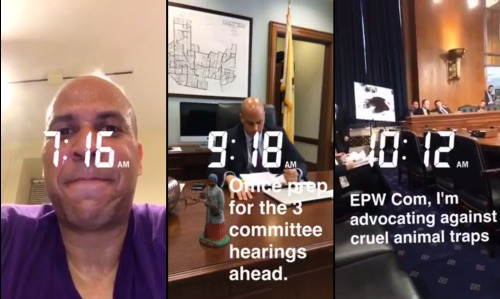
Photo: Snapchat
Yahoo News interviewed Booker to ask him about how he views Snapchat, why it might be useful for other politicians and whether he’s different when he’s representing himself vs. Clinton on the campaign trail. Below is a transcript of that conversation, lightly edited for clarity.
Yahoo News: Do you have a strategy for how you use Snapchat and what do you think is its actual utility for politicians or even unelected users?
Cory Booker: It’s a new platform and I want to try to be one of those folks that explores the possibility of a new platform to do some of the things that I think are important to do in an elected office, which is to give more transparency, to find ways to inform, to find ways to engage, to find ways to exchange ideas and connect with your constituency.
I’ve had a lot of very positive experience with past platforms — and I don’t mean “past” in that they’re not relevant anymore — but platforms like Twitter and Facebook and Instagram. … It’s very successful in moving the needle on exactly those things that I mentioned, from doing constituent concern work on Twitter, whether it’s me communicating with frustrated commuters, it really helped us to gather momentum for getting the Hudson rail tunnels built. Whether it’s sharing inspirational ideas with people or seeing articles that people send to me over Facebook and Twitter. These platforms can actually be very, very powerful.
And so now, along comes Snapchat, which is definitely unique and different from the other platforms and is engaging a wide variety of people — a lot of young people are really engaged with it. And so just a matter of weeks ago, much to my staff holding their breath, I just jumped off one day and decided to get on Snapchat and see what I could do with the platform that could be creative and innovative in achieving those core values of engagement, transparency, inspiration, communication with my constituents. And it’s been a great success so far.
At this point, I now meet people as I’m traveling around New Jersey and in fact, now also as I’m traveling around South Carolina, Nevada and New Hampshire [for Clinton] who are seeing my snaps and appreciate the fact that they understand more about the day in the life [of a senator], understand what motivates me sometimes, inspires me, it makes the federal government a lot closer to them, where they can feel like they connect.
So I hope some of the result is that it engages, activates, inspires and informs people.
Are you different when you’re representing yourself versus when you’re out for Clinton? I know you took over her campaign’s Snapchat account in Iowa.
I just have a big belief in authenticity. I was talking to another colleague about this recently, that if you’re on social media, it’s just so important to be authentic.
On Snapchat, I’m trying to show people a real view of what this elected leader is doing on a regular basis, and it happens to be in the midst of an intense, tough primary battle. So yeah, there are days that I’m in Washington, like right now, chasing down my colleagues to talk about legislation, going to a morning prayer breakfast, about to go to the floor and vote. And then there are days like tomorrow, when I’ll be in South Carolina, running around trying to work hard for Hillary Clinton.

Photo: Snapchat
I just try to keep it real and be authentic and take risks, you know, I think that’s important, as long as you keep what your values are, what you’re really going for and really bring government closer to people. Let folks understand that this isn’t some high-on-the-hill, faraway government body, that the people here are fellow Americans trying to get a job done. And in fact, there are a lot of great Americans — in fact, this is why I try often on my platforms to try to focus on the people whose names you might not read in the paper, but who are essential to this place, whether it’s the person that cleans the offices or the Senate pages that are running around working so hard on behalf of the Senate or the police officers who keep us secure.
But politicians are notoriously poll-tested and managed. I think there are a lot of your colleagues who would struggle to be “authentic” in the way you are describing and others would be less excited to be included in their efforts.
Authenticity means doing what is natural to you. Some of my colleagues do a lot of things that if I tried to do, it would be very inauthentic. I am a Generation X guy who was geeky and nerdy growing up. I had two parents who worked for IBM so I was on computers before my friends were playing computer games, even trying to build them on my old, clunky, IBM. It’s just who I am and I’m going to try to stay true to that.
Social media, in less than a decade, has transformed our society. This is the future. It’s coming. And these platforms are becoming more and more valuable. How do you know that? Corporations are rushing into these spaces. Entertainment, artists, Generation X and millennials, your and mine generation, this is becoming as commonplace as a typewriter. A smartphone is a typewriter. It’s becoming ubiquitous.
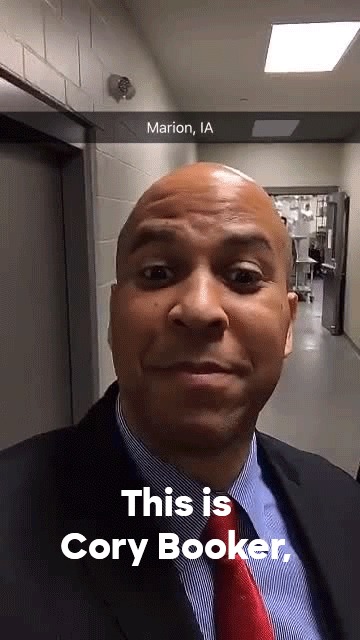
What would you say to skeptics of a platform like Snapchat?
I am so busy, running around the country, doing this job that takes me down to D.C. away from New Jersey and I find now that my friends, like one of my closest friends from fourth grade … he and his wife have been constants in my life, but I don’t see them as much. Suddenly I’m on Snapchat and now with him and his kids and his wife, because we’re all just loving, I actually thought to myself, we’re more connected now with these windows into their lives. I watched him as a family making dinner last night in a snap just for me, so we’re talking about the public version of it, but I encourage you because when it comes to enriching relationships and having fun, deepening connections … having tools like this, it’s really great.


